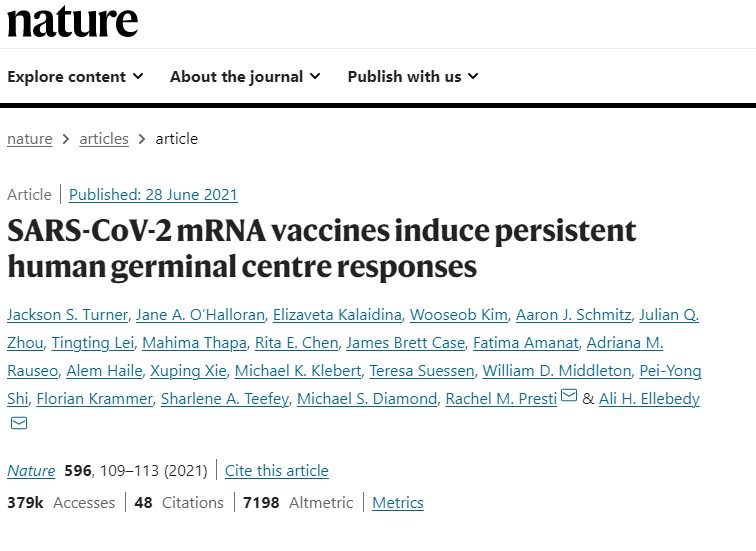
Main
The concept of using mRNAs as vaccines was introduced over 30 years ago6,7. Key refinements that improved the biological stability and translation capacity of exogenous mRNA enabled development of these molecules as vaccines8,9. The emergence of SARS-CoV-2 in December 2019, and the ensuing pandemic, has revealed the potential of this platform9,10,11. Hundreds of millions of people have received one of the two SARS-CoV-2 mRNA-based vaccines that were granted emergency use authorization by the US Food and Drug Administration in December 2020. Both of these vaccines demonstrated notable immunogenicity in phase-I/II studies and efficacy in phase-III studies1,2,3,4,12,13,14. Whether these vaccines induce the robust and persistent germinal centre reactions that are critical for generating high-affinity and durable antibody responses has not been examined in humans. To address this question, we conducted an observational study of 41 healthy adults (8 of whom had a history of confirmed SARS-CoV-2 infection) who received the Pfizer–BioNTech SARS-CoV-2 mRNA vaccine BNT162b2 (Extended Data Tables 1, 2). Blood samples were collected at baseline, and at weeks 3 (pre-boost), 4, 5, 7 and 15 after the first immunization. Fine needle aspirates (FNAs) of the draining axillary lymph nodes were collected from 14 participants (none with history of SARS-CoV-2 infection) at weeks 3 (pre-boost), 4, 5, 7, and 15 after the first immunization (Fig. 1a).
BIBLIOGRAPHY
SARS-CoV-2 mRNA vaccines induce persistent human germinal centre responses Jackson S. Turner, Jane A. O’Halloran, Elizaveta Kalaidina, Wooseob Kim, Aaron J. Schmitz, Julian Q. Zhou, Tingting Lei, Mahima Thapa, Rita E. Chen, James Brett Case, Fatima Amanat, Adriana M. Rauseo, Alem Haile, Xuping Xie, Michael K. Klebert, Teresa Suessen, William D. Middleton, Pei-Yong Shi, Florian Krammer, Sharlene A. Teefey, Michael S. Diamond, Rachel M. Presti & Ali H. Ellebedy
Nature volume 596, pages109–113 (2021)
SOURCE LINK: